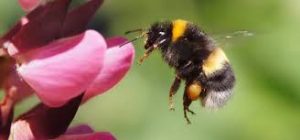25
Oct
Bees’ Medicine Chest Should Include Sunflower Pollen, Study Finds
 (Beyond Pesticides, October 25, 2018) A study published last month in Scientific Reports finds that eating sunflower pollen significantly reduces protozoan infection in bumblebees. Studying ecosystem services and what she calls “floral rewards,” evolutionary ecologist Lynn Adler, Ph.D. at the University of Massachusetts Amherst says sunflowers may provide a long sought after solution for improving bees’ immune system response to both disease and parasites.
(Beyond Pesticides, October 25, 2018) A study published last month in Scientific Reports finds that eating sunflower pollen significantly reduces protozoan infection in bumblebees. Studying ecosystem services and what she calls “floral rewards,” evolutionary ecologist Lynn Adler, Ph.D. at the University of Massachusetts Amherst says sunflowers may provide a long sought after solution for improving bees’ immune system response to both disease and parasites.
The researchers studied the protozoan Crithidia bombi, a common parasitic infection of bumble bees, known to impair learning and foraging, shorten lifespan and destabilize colony hierarchies by impacting queen bee behavior. From the outset of the study, Dr. Adler says, “the more sunflowers were grown at the farm, the lower the Crithidia load for the bees at that farm.” Knowing pollinators eat pollen as a source of protein and healthy fats, Dr. Adler hypothesized that both pollen and nectar might have medicinal effects against disease and parasites. However, her experiment did not show consistent results with nectar.
After bees in the lab were starved for 4-6 hours, researchers fed individual worker bees from small colonies a drop of fructose fluid containing 6,000 Crithidia cells, being the approximate concentration bees may encounter in the wild while foraging. After administering the infection, researchers randomly assigned bees to one of four pollen diets: sunflower, buckwheat, or rapeseed, as well as a fourth mix of all three, thus comparing monofloral diets to more natural integration of pollen sources found in the wild. Ensuring samples were free from contaminants, pollen samples were analyzed for 213 pesticides and other agrichemicals. One week after bees were first infected, researchers measured the change to Crithidia infection intensity in the insects.
Though mortality was not different for bees receiving the different treatments, researchers found all bees exhibited improved reproduction success when fed sunflower pollen. In addition, the bees’ Crithidia infection was significantly reduced, suggesting sunflower pollen, as opposed to nectar, has far more concentrated defensive chemicals, and, therefore, can have broad anti-parasitic effects.
However, noting sunflower pollen is not a silver bullet, Dr. Alder indicates that, “Bees do not do well eating just sunflower, but it may be part of a solution. They are going to need other and varied food for their health. . .[Nevertheless,] incorporating [sunflowers] into pollinator gardens is a simple thing we can do to help bees.”
The causes of pollinator decline are multiple and complex: pests and diseases, diet and nutrition, genetics, and habitat loss are all contributors to pollinator decline, according to the 2012 Congressional Research Service report. However the science is clear that systemic pesticides, like the neonicotinoid class of insecticides, are having the greatest effect in depressing pollinator populations. As long as there has been pesticide-intensive agriculture, bees and other pollinators have encountered substantial health risks during and after crop pollination, highlighting a persistent flaw in the U.S. approach to pesticide regulation.
Even interspersing clover into managed landscapes and urban green spaces is shown to add high quality nutritional diversity to the pollen diets of foraging bees in hopes a varied pollen diet reduces susceptibility to pesticide stress and improves resistance to pesticides that affect multiple generations. A 2014 study from Pennsylvania State University, uncovering further evidence that pesticides impair pollinator immune system function, found that bees with a diet of natural, high quality pollen exhibit greater resistance to pesticides’ damaging effects than bees on an artificial diet.
“Given consistent effects of sunflower in reducing pathogens, planting sunflower in agroecosystems and native habitat,” says Adler, “may provide a simple solution to reduce disease and improve the health of economically and ecologically important pollinators.”
Protecting pollinators is vital to American agriculture. Such widespread use of systemic pesticides and the resulting decline of pollinators threatens the stability of the global economy and food supply, along with ecosystems and human health. Before winter sets in, begin to manage landscapes with pollinators in mind. Prepare a space in your yard where you can plant organic sunflower seeds or plant starts, not poisoned with neonicotinoids or other pesticides. Sunflowers are not a cure to all bee diseases. Nevertheless, apathy; an unwillingness to act when necessity dictates action, can be a toxin as potent as any pesticide. See www.BEEProtective.org to find out how you, as part of a grassroots coalition, can get your community, schools, and local government to take action to protect pollinators.
All unattributed positions and opinions in this piece are those of Beyond Pesticides.
Source: EurekaAlert, Scientific Reports










